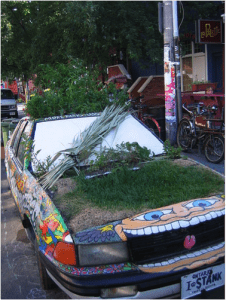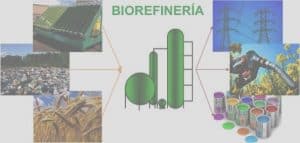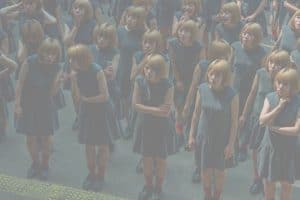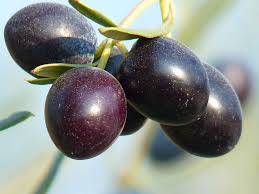Do you like the sea? I think so! And if I ask you to tell me about marine animals or vegetables, which ones would you talk about? Let me guess: fishes, sharks, dolphins, whales, crabs, turtles, algae, jelly-fishes… and plankton. PLANKTON? Who said Plankton? I’m sure he/she must be a fan of SpongeBob!! But what is plankton?
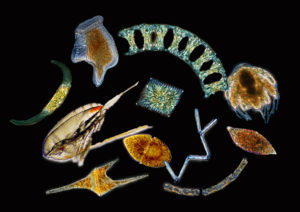 Plankton is the term that marine scientists use to define organisms (animals, algae or bacteria) which float in the water and drift on the oceanic currents. Usually they are microscopic, which is why we do not see them unless we have a magnifier or a microscope. Although some species are quite large, for example: jellyfish. Yes, jellyfish are plankton, but today I would like to introduce you to the microscopic and more unknown ones. Plankton organisms are so small, that there are thousands in a single drop of water. They come in many different shapes, sizes and a range of beautiful colours. If you don’t believe me, check out this website and see for yourself at Plankton Chronicles I love it!!
Plankton is the term that marine scientists use to define organisms (animals, algae or bacteria) which float in the water and drift on the oceanic currents. Usually they are microscopic, which is why we do not see them unless we have a magnifier or a microscope. Although some species are quite large, for example: jellyfish. Yes, jellyfish are plankton, but today I would like to introduce you to the microscopic and more unknown ones. Plankton organisms are so small, that there are thousands in a single drop of water. They come in many different shapes, sizes and a range of beautiful colours. If you don’t believe me, check out this website and see for yourself at Plankton Chronicles I love it!!
But why are plankton so important? I can give you many different reasons, but I will only stick to three: firstly, they are at the base of the marine food chain, so they are the food for all the other organisms; secondly, they produce 50% of the oxygen we breathe and thirdly, they produce CO2, one of the greenhouse gases responsible for climate change (something Javier talked about in a previous blog entry).
But, let’s break this down. Fish larvae, fish and some whales feed on phytoplankton and zooplankton. Phytoplankton (or microalgae) are similar to terrestrial plants in that they contain chlorophyll and require sunlight in order to live, whereas zooplankton are animal plankton. Plankton are at the base of marine food webs (Figure 1). Without them, many larger organisms (fish and shellfish) would probably die, and marine life would change dramatically.
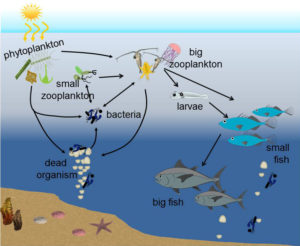
Fig 1. Marine food chain
But, are these tiny organisms really producing 50 % of the oxygen we breathe? Surprisingly, the answer is yes! In a manner similar to trees within a terrestrial ecosystem, phytoplankton produce oxygen through photosynthesis (also called primary production). Primary production is the process of converting CO2 and water into organic matter and oxygen using light as the energy source (Figure 2). All plankton (phyto-, zooplankton and bacteria) respire. Respiration is the opposite process to primary production: the breakdown (or degradation) of organic matter into CO2 and water, using oxygen as the energy source.
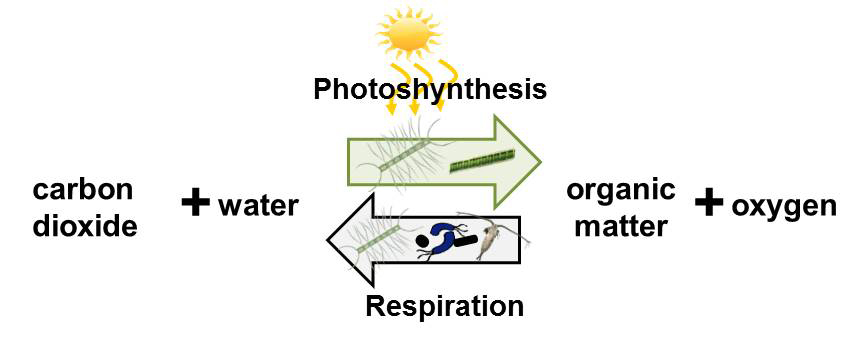
Figure 2. Photosynthesis and respiration equations
Therefore, whilst photosynthesis requires light, respiration may occur in light or dark conditions. This means that, in the first meters of the ocean, where light from the sun can penetrate, there is both production and consumption of CO2 and oxygen. However in the deep ocean, where there is no sun light and it is dark, there is only respiration. Here, there is a production of CO2 that acidifies the deep waters.
In the depths of the ocean where light can reach, if photosynthesis is greater than respiration, we say that the ocean is productive, there is an excess of oxygen. This excess interchanges with the atmosphere and CO2 from the atmosphere is taken into the sea. In addition, in productive systems there is a higher phytoplankton concentration, which is the food for zooplankton, then larvae and finally larger animals (you may like to look again Figure 1). However where respiration is greater than primary production, more CO2 is produced than absorbed, so the system is not productive. This excess of CO2 in the ocean may be transferred to the atmosphere. In non-productive areas, bacteria and small microorganism tend to dominate, and the lack of bigger organisms means a smaller food chain.
Which factors drive an increase in primary production and respiration? The answer is, there are many! For example: the quantity and quality of the light, temperature, an increase in nutrients that can come from the atmosphere (like the rain or dust) or rivers, a change in the quality of the nutrients (for example a change in the composition of the carbon, nitrogen and phosphorus molecules), among others. And this is what I am studying right now: how the quality of the organic matter affects plankton respiration, with especial attention to bacterial respiration. I will have the results from my recent work in a couple of weeks, so I will return with an update in the future. Today, I just wanted to introduce you to plankton: the microscopic organisms that could help us to have a better future, if we became aware that the ocean is to enjoy it and to protect it.
If any of this has got you curious, and you would like to know more about plankton or about the project I’m working on, you can find out more about oceanography and plankton on the project webpage: Shelf Sea Biogeochemistry. And don´t forget to watch the different short films at Plankton Chronicles.
By Dr Elena García-Martín, Postdoctoral Researcher, University of East Anglia. SRUK Cambridge Constituency.

